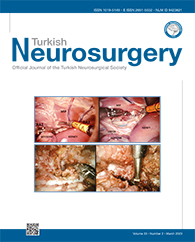2Department of Neurosurgery of FBHC and Neurosurgery Service, Aracaju, Sergipe, Brazil
3University of Sapucaí Valley, Pouso Alegre-MG, Brazil
4Division of Neurosurgery, Hospital das Clínicas da Faculdade de Medicina da Universidade de São Paulo (FMUSP), São Paulo, Brazil DOI : 10.5137/1019-5149.JTN.37055-21.3 AIM: To review the literature, and to identify the main intracranial pathologies that cause sudden deaths in adults.
MATERIAL and METHODS: The systematic review was carried out in concordance with the PRISMA checklist.
RESULTS: Epilepsy and intracranial hemorrhage have been found to be the two main causes of sudden and unexplained deaths in adults due to intracranial pathologies. Intracranial neoplasms are not among the two main causes of SD, as they are usually discovered before fatality, so their rate of SD is not so extensive. It is noticed that the highest incidence of this type of death is also related to the abusive use of alcohol and other drugs, such as cocaine, heroin and nicotine. There is a possibility that the actual incidence of SD in adults due to intracranial pathologies is even greater, since there is a lack of reliability in autopsies and the fact that most SD in adults are not witnessed.
CONCLUSION: The most recurrent etiologies of SD in adults are epilepsy, intracranial hemorrhage, meningitis or purulent abscess and tumors. Thus, it represents real challenge for neurosurgeons, since their understanding, accurate diagnosis and adequate treatment of these pathologies, in addition to healthy lifestyle habits by people can reduce the possibility of SD.
Keywords : Sudden death, Intracranial pathology, Intracranial findings, SUDEP, Forensic medicine




